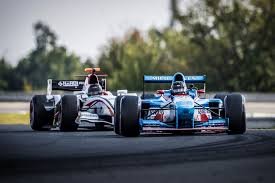The word “monoposto racing” conjures up the unadulterated spirit of racing. You’re exactly correct if you picture a sleek, low-to-the-ground, single-seat rocket speeding around the track.
The term “monoposto racing“, which comes from the Italian terms “mono” (single) and “posto” (seat), describes racing cars with only one seat that are intended for one thing: maximum performance on the track.
History of Monoposto
Early in the 20th century, when the world was only beginning to experience vehicle technology, monoposto racing had its start.
As Grand Prix racing gained popularity in Europe in the 1910s and 1920s, automakers like Bugatti and Alfa Romeo created customised single-seater cars specifically for competition.
Monoposto racing isn’t exclusive to Formula One anymore. It has given aspiring drivers the chance to establish themselves in the racing world by inspiring many feeder series, such as Formula 2, Formula 3, and regional championships worldwide.
Technical Marvels: Engineering the Speed Machines.
Performance-enhancing aerodynamics Use diffusers, bargeboards, and front and rear wings to control airflow.
To achieve 50% thermal efficiency, hybrid Power Units (PUs) that combine 1.6L V6 turbo engines with Energy Recovery Systems (ERS) are used in modern Formula One vehicles.
The sport’s dedication to driver safety is demonstrated by safety advancements like the Halo device (2018) and biometric gloves.
In contrast to production automobiles, Monoposto designs allow for cornering forces greater than 6G by prioritising downforce above comfort.
Major Monoposto Series: A Spectrum of Speed
- Formula 1: The pinnacle, with its world-renowned athletes and state-of-the-art technology. Every year, teams like Mercedes and Ferrari compete in over 23 events.
- An American mainstay, the Indianapolis 500 is held on high-speed oval courses.
- Since 2014, Formula E has promoted sustainable mobility through electric racing on city circuits.
- Junior Formulas: F2 and F3 emphasise cost-effective competitiveness and act as talent pipelines.
- Established in 1958, the UK-based Monoposto Racing Club hosts affordable entry-level races including both vintage and contemporary vehicles.
Each series caters to audiences and technological objectives while striking a balance between innovation, expense, and spectacle.
Safety Innovations: From Tragedy to Transformation
Circuit upgrades and full-face helmets were the results of Jackie Stewart’s efforts following the 1960s crashes.
The death of Ayrton Senna in 1994 hastened the adoption of technological assistance like crash-test requirements and traction control.
The 2020 crash survival of Romain Grosjean is proof that the HANS device (2000s) and Halo (2018) have saved lives.
The sport’s changing safety philosophy is highlighted by ongoing advancements in barrier technology and virtual safety vehicles.
Legends and Machines: Icons of the Track
The drama in sports is fuelled by legendary rivalries like Hamilton vs. Verstappen and Prost vs. Senna. Legendary vehicles include the Ferrari F2004 (dominant aerodynamics) and Lotus 79 (ground effect pioneer).
The chassis, which is the backbone of a Monoposto automobile, is often made of carbon fibre monocoque, a single piece of shell that offers the highest level of stiffness and safety.
The chassis, which is very sturdy and lightweight, makes sure that all of the power is effectively transmitted to the track.
The path to inclusiveness is paved by women like Jamie Chadwick, a three-time W Series winner, and Lella Lombardi, the sole female F1 points scorer.
Cultural Impact: Beyond the Track
From computer games like F1 2023 to films like Rush (2013) and Senna (2010), monoposto racing is seen in many forms of media.
Events like the Monaco Grand Prix combine luxury and history, while brands use sponsorships to tap into worldwide fan communities. Particularly during COVID-19, esports and sim racing increased accessibility and attracted younger viewers.
The Future: Sustainability and Innovation
Research on synthetic fuels and Formula One’s 2030 carbon-neutral target are in line with environmental trends.
The Gen3 vehicle from Formula E in 2023 is a fantastic example of electric advancement. While programmes like “We Race As One” encourage diversity, AI and machine learning optimise automobile designs.
Conclusion
Its reputation as a testing ground for innovation is uncontested, as it promotes sustainability and inclusion.
The quest for speed and perfection remains, enthralling generations past, present, and future, whether it be through screaming engines or whisper-quiet electric vehicles.






